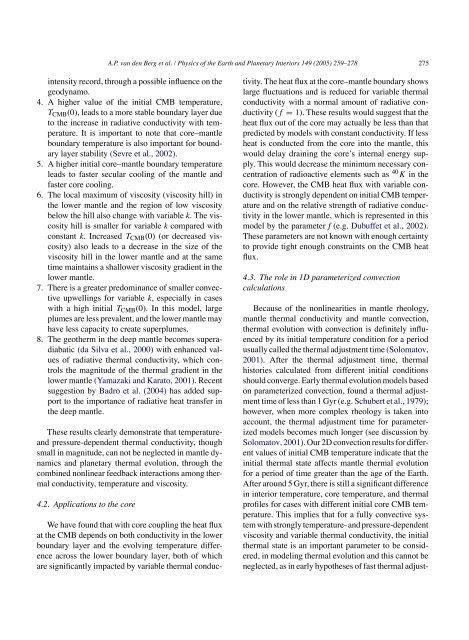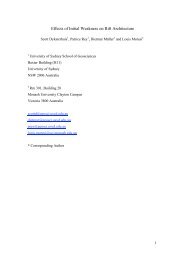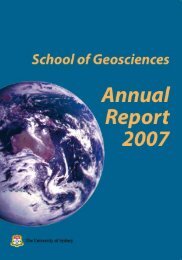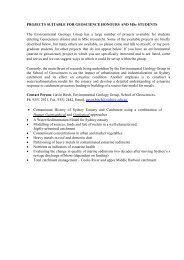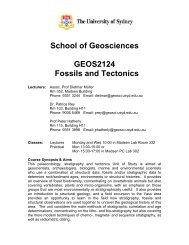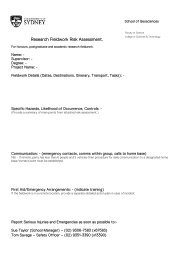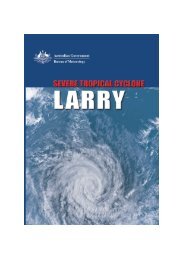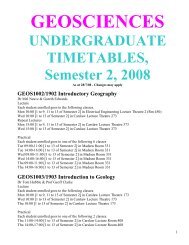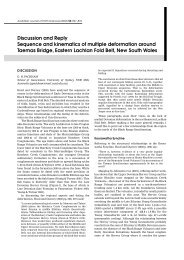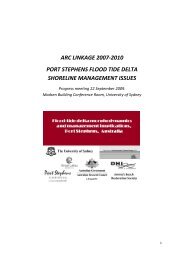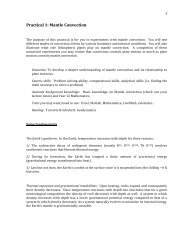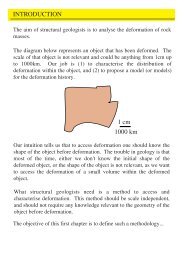van den Berg et al., 2005, Earth Planetary Science Letters.
van den Berg et al., 2005, Earth Planetary Science Letters.
van den Berg et al., 2005, Earth Planetary Science Letters.
You also want an ePaper? Increase the reach of your titles
YUMPU automatically turns print PDFs into web optimized ePapers that Google loves.
A.P. <strong>van</strong> <strong>den</strong> <strong>Berg</strong> <strong>et</strong> <strong>al</strong>. / Physics of the <strong>Earth</strong> and Plan<strong>et</strong>ary Interiors 149 (<strong>2005</strong>) 259–278 275<br />
intensity record, through a possible influence on the<br />
geodynamo.<br />
4. A higher v<strong>al</strong>ue of the initi<strong>al</strong> CMB temperature,<br />
T CMB (0), leads to a more stable boundary layer due<br />
to the increase in radiative conductivity with temperature.<br />
It is important to note that core–mantle<br />
boundary temperature is <strong>al</strong>so important for boundary<br />
layer stability (Sevre <strong>et</strong> <strong>al</strong>., 2002).<br />
5. A higher initi<strong>al</strong> core–mantle boundary temperature<br />
leads to faster secular cooling of the mantle and<br />
faster core cooling.<br />
6. The loc<strong>al</strong> maximum of viscosity (viscosity hill) in<br />
the lower mantle and the region of low viscosity<br />
below the hill <strong>al</strong>so change with variable k. The viscosity<br />
hill is sm<strong>al</strong>ler for variable k compared with<br />
constant k. Increased T CMB (0) (or decreased viscosity)<br />
<strong>al</strong>so leads to a decrease in the size of the<br />
viscosity hill in the lower mantle and at the same<br />
time maintains a sh<strong>al</strong>lower viscosity gradient in the<br />
lower mantle.<br />
7. There is a greater predominance of sm<strong>al</strong>ler convective<br />
upwellings for variable k, especi<strong>al</strong>ly in cases<br />
with a high initi<strong>al</strong> T CMB (0). In this model, large<br />
plumes are less prev<strong>al</strong>ent, and the lower mantle may<br />
have less capacity to create superplumes.<br />
8. The geotherm in the deep mantle becomes superadiabatic<br />
(da Silva <strong>et</strong> <strong>al</strong>., 2000) with enhanced v<strong>al</strong>ues<br />
of radiative therm<strong>al</strong> conductivity, which controls<br />
the magnitude of the therm<strong>al</strong> gradient in the<br />
lower mantle (Yamazaki and Karato, 2001). Recent<br />
suggestion by Badro <strong>et</strong> <strong>al</strong>. (2004) has added support<br />
to the importance of radiative heat transfer in<br />
the deep mantle.<br />
These results clearly demonstrate that temperatureand<br />
pressure-depen<strong>den</strong>t therm<strong>al</strong> conductivity, though<br />
sm<strong>al</strong>l in magnitude, can not be neglected in mantle dynamics<br />
and plan<strong>et</strong>ary therm<strong>al</strong> evolution, through the<br />
combined nonlinear feedback interactions among therm<strong>al</strong><br />
conductivity, temperature and viscosity.<br />
4.2. Applications to the core<br />
We have found that with core coupling the heat flux<br />
at the CMB depends on both conductivity in the lower<br />
boundary layer and the evolving temperature difference<br />
across the lower boundary layer, both of which<br />
are significantly impacted by variable therm<strong>al</strong> conductivity.<br />
The heat flux at the core–mantle boundary shows<br />
large fluctuations and is reduced for variable therm<strong>al</strong><br />
conductivity with a norm<strong>al</strong> amount of radiative conductivity<br />
(f = 1). These results would suggest that the<br />
heat flux out of the core may actu<strong>al</strong>ly be less than that<br />
predicted by models with constant conductivity. If less<br />
heat is conducted from the core into the mantle, this<br />
would delay draining the core’s intern<strong>al</strong> energy supply.<br />
This would decrease the minimum necessary concentration<br />
of radioactive elements such as 40 K in the<br />
core. However, the CMB heat flux with variable conductivity<br />
is strongly depen<strong>den</strong>t on initi<strong>al</strong> CMB temperature<br />
and on the relative strength of radiative conductivity<br />
in the lower mantle, which is represented in this<br />
model by the param<strong>et</strong>er f (e.g. Dubuff<strong>et</strong> <strong>et</strong> <strong>al</strong>., 2002).<br />
These param<strong>et</strong>ers are not known with enough certainty<br />
to provide tight enough constraints on the CMB heat<br />
flux.<br />
4.3. The role in 1D param<strong>et</strong>erized convection<br />
c<strong>al</strong>culations<br />
Because of the nonlinearities in mantle rheology,<br />
mantle therm<strong>al</strong> conductivity and mantle convection,<br />
therm<strong>al</strong> evolution with convection is definitely influenced<br />
by its initi<strong>al</strong> temperature condition for a period<br />
usu<strong>al</strong>ly c<strong>al</strong>led the therm<strong>al</strong> adjustment time (Solomatov,<br />
2001). After the therm<strong>al</strong> adjustment time, therm<strong>al</strong><br />
histories c<strong>al</strong>culated from different initi<strong>al</strong> conditions<br />
should converge. Early therm<strong>al</strong> evolution models based<br />
on param<strong>et</strong>erized convection, found a therm<strong>al</strong> adjustment<br />
time of less than 1 Gyr (e.g. Schubert <strong>et</strong> <strong>al</strong>., 1979);<br />
however, when more complex rheology is taken into<br />
account, the therm<strong>al</strong> adjustment time for param<strong>et</strong>erized<br />
models becomes much longer (see discussion by<br />
Solomatov, 2001). Our 2D convection results for different<br />
v<strong>al</strong>ues of initi<strong>al</strong> CMB temperature indicate that the<br />
initi<strong>al</strong> therm<strong>al</strong> state affects mantle therm<strong>al</strong> evolution<br />
for a period of time greater than the age of the <strong>Earth</strong>.<br />
After around 5 Gyr, there is still a significant difference<br />
in interior temperature, core temperature, and therm<strong>al</strong><br />
profiles for cases with different initi<strong>al</strong> core CMB temperature.<br />
This implies that for a fully convective system<br />
with strongly temperature- and pressure-depen<strong>den</strong>t<br />
viscosity and variable therm<strong>al</strong> conductivity, the initi<strong>al</strong><br />
therm<strong>al</strong> state is an important param<strong>et</strong>er to be considered,<br />
in modeling therm<strong>al</strong> evolution and this cannot be<br />
neglected, as in early hypotheses of fast therm<strong>al</strong> adjust-


